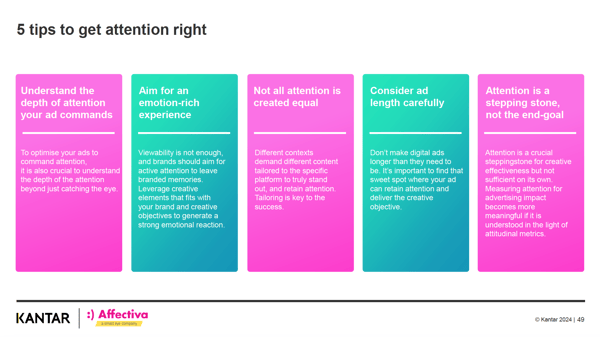In digital advertising, capturing and maintaining attention is a critical challenge. During a recent webinar, industry experts delved into the nuances of attention and its pivotal role in the effectiveness of creative content. This blog post will unravel the key insights shared during the webinar, focusing on the analysis of attention in various ads, platforms, and the creative elements that contribute to success.
Understanding Attention: The Core of Creative Effectiveness
The webinar emphasized that attention is not a one-size-fits-all concept. Both passive and active attention play distinct roles in determining the impact of an advertisement. Passive attention measures the extent to which viewers are open to a message, while active attention gauges the depth of engagement through facial expressions and reactions.
Tailoring Content for Platforms: The Uber Case Study
The discussion turned to a case study featuring Uber's campaign promoting their in-app train booking feature. Three ads from the campaign were examined, each tailored for different platforms–YouTube and TikTok. The analysis revealed that understanding platform characteristics is crucial for effective content creation.
- Gina on YouTube: Originally a TV spot repurposed for YouTube, Gina's humor-driven content successfully engaged viewers. The forced start on YouTube influenced passive attention, while active attention increased as the humorous interaction unfolded.
- TikTok Collaborations: User-created content by influencers Jack Joseph and NDA targeted a younger audience. While lower in passive attention, these ads excelled in active attention due to emotional connections and relatable humor.
The Power of Nostalgia: Netflix's Farewell Ad
Shifting gears, the webinar explored Netflix's farewell ad, bidding adieu to their DVD rental service. The ad leveraged nostalgia, creating a strong emotional connection. Nostalgic elements significantly increased active attention, demonstrating the effectiveness of emotion-driven storytelling.
Q&A Session: Addressing Key Queries
Differentiating Passive and Active Attention: Responding to a question, the speakers highlighted the methodological distinctions between passive and active attention. Passive attention gauges openness to a message, while active attention measures deeper engagement, often showcased through facial expressions.
Balancing Short-term vs. Long-term Goals: Another query probed into whether brands should prioritize short-term sales or long-term impact. The speakers emphasized the interplay between passive and active attention, asserting that active attention, driven by emotional connections, correlates more strongly with sales effects.
Optimal Ad Length Across Platforms: When asked about the ideal ad length for various platforms, the speakers emphasized the need for balance. While longer ads allow for narrative depth, shorter ads may suffice for simpler messages. The key is finding the sweet spot that retains attention without overstaying.
The Bottom Line: Crafting Impactful Ads in the Digital Landscape
In conclusion, the webinar shed light on the multifaceted nature of attention and its role in creative effectiveness. Crafting ads that resonate requires a nuanced understanding of both passive and active attention, platform characteristics, and the emotional elements that drive engagement. As brands navigate the digital advertising landscape, the key takeaway is clear: attention alone is not enough; it's the emotional connection that makes an ad truly impactful.








